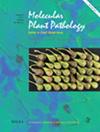根结线虫利用类似过氧化氢酶的效应器,通过直接降解 H2O2 来操纵植物活性氧水平
IF 4.8
1区 农林科学
Q1 PLANT SCIENCES
引用次数: 0
摘要
植物在受到感染时会产生活性氧(ROS),通常会触发防御机制并阻碍病原体的增殖。根结线虫(RKNs,Meloidogyne spp.)是一种危害性极大的病原体,能够寄生于多种作物,造成每年大量的农业损失。ROS 参与 RKN 的寄生已得到公认。在这项研究中,我们从黑僵菌(Meloidogyne incognita)中鉴定出了一种新型效应物,命名为 CATLe,它含有一个保守的过氧化氢酶结构域,具有调节宿主 ROS 水平的潜在功能。系统进化分析表明,CATLe 在 RKNs 中是保守的。时间和空间表达分析表明,CATLe基因在M. incognita感染早期特异性上调,并在其腹下食道腺细胞中积累。免疫定位证明,CATLe 在 M. incognita 寄生期间分泌到寄主植物的巨细胞中。CATLe的瞬时表达能显著抑制flg22诱导的ROS在烟草中的产生。植物实验证实,M. incognita可以利用CATLe直接降解H2O2来操纵寄主的ROS水平。此外,通过双链 RNA 浸泡和宿主诱导的基因沉默干扰 CATLe 基因的表达,可显著降低 M. incognita 的寄生能力,这突出了 CATLe 的重要作用。综上所述,我们的研究结果表明,RKNs可以利用功能性过氧化氢酶直接降解ROS产物,从而操纵宿主的ROS水平并促进寄生。本文章由计算机程序翻译,如有差异,请以英文原文为准。
Root‐knot nematodes exploit the catalase‐like effector to manipulate plant reactive oxygen species levels by directly degrading H2O2
Plants produce reactive oxygen species (ROS) upon infection, which typically trigger defence mechanisms and impede pathogen proliferation. Root‐knot nematodes (RKNs, Meloidogyne spp.) represent highly detrimental pathogens capable of parasitizing a broad spectrum of crops, resulting in substantial annual agricultural losses. The involvement of ROS in RKN parasitism is well acknowledged. In this study, we identified a novel effector from Meloidogyne incognita , named CATLe, that contains a conserved catalase domain, exhibiting potential functions in regulating host ROS levels. Phylogenetic analysis revealed that CATLe is conserved across RKNs. Temporal and spatial expression assays showed that the CATLe gene was specifically up‐regulated at the early infection stages and accumulated in the subventral oesophageal gland cells of M. incognita . Immunolocalization demonstrated that CATLe was secreted into the giant cells of the host plant during M. incognita parasitism. Transient expression of CATLe significantly dampened the flg22‐induced ROS production in Nicotiana benthamiana . In planta assays confirmed that M. incognita can exploit CATLe to manipulate host ROS levels by directly degrading H2 O2 . Additionally, interfering with expression of the CATLe gene through double‐stranded RNA soaking and host‐induced gene silencing significantly attenuated M. incognita parasitism, highlighting the important role of CATLe. Taken together, our results suggest that RKNs can directly degrade ROS products using a functional catalase, thereby manipulating host ROS levels and facilitating parasitism.
求助全文
通过发布文献求助,成功后即可免费获取论文全文。
去求助
来源期刊

Molecular plant pathology
生物-植物科学
CiteScore
9.40
自引率
4.10%
发文量
120
审稿时长
6-12 weeks
期刊介绍:
Molecular Plant Pathology is now an open access journal. Authors pay an article processing charge to publish in the journal and all articles will be freely available to anyone. BSPP members will be granted a 20% discount on article charges. The Editorial focus and policy of the journal has not be changed and the editorial team will continue to apply the same rigorous standards of peer review and acceptance criteria.
 求助内容:
求助内容: 应助结果提醒方式:
应助结果提醒方式:


